GHGs Emission from the Agricultural Sector within EU-28: A Multivariate Analysis Approach
Abstract
1. Introduction
2. Materials and Methods
2.1. Data Collection
2.2. Trend Analysis
2.3. Multivariate Analysis
3. Empirical Findings
3.1. Trend Analysis of GHGs Emissions between 1990 and 2019
3.1.1. Total GHGs Emissions between 1990 and 2019
3.1.2. CO2 Emissions between 1990 and 2019
3.1.3. CH4 Emissions between 1990 and 2019
3.1.4. N2O Emissions between 1990–2019
3.2. Multivariate Analysis of GHGs Emissions in 1990 and 2019
4. Discussion
5. Conclusions
Author Contributions
Funding
Institutional Review Board Statement
Informed Consent Statement
Data Availability Statement
Acknowledgments
Conflicts of Interest
References
- Dale, A.; Robinson, J.; King, L.; Burch, S.; Newell, R.; Shaw, A.; Jost, F. Meeting the climate change challenge: Local government climate action in British Columbia, Canada. Clim. Policy 2020, 20, 866–880. [Google Scholar] [CrossRef]
- Mohammed, S.; Gill, A.R.; Alsafadi, K.; Hijazi, O.; Yadav, K.K.; Khan, A.H.; Harsanyi, E. An overview of greenhouse gases emissions in Hungary. J. Clean. Prod. 2021, 127865. [Google Scholar] [CrossRef]
- Shakoor, A.; Ashraf, F.; Shakoor, S.; Mustafa, A.; Rehman, A.; Altaf, M.M. Biogeochemical transformation of greenhouse gas emissions from terrestrial to atmospheric environment and potential feedback to climate forcing. Environ. Sci. Pollut. Res. 2020, 27, 38513–38536. [Google Scholar] [CrossRef]
- IPCC (Intergovernmental Panel on Climate Change). Climate Change 2014: Mitigation of Climate Change. Working Group III Contribution to The IPCC Fifth Assessment Report; Cambridge University Press: Cambridge, UK, 2014; Available online: www.ipcc.ch/report/ar5/wg3 (accessed on 3 March 2021).
- WRI (World Resources Institute). Climate Watch Historical GHGE. Available online: www.climatewatchdata.org/ghg-emissions. (accessed on 3 March 2021).
- FAO (Food and Agriculture Organization). FAOSTAT Emissions Database—Land Use Indicators. Available online: www.fao.org/faostat/en/#data/EL. (accessed on 24 March 2021).
- IPCC (Intergovernmental Panel on Climate Change). Climate Change: The Physical Science Basis. Working Group I Contribution to the IPCC Fifth Assessment Report; Cambridge University Press: Cambridge, UK, 2013; Available online: www.ipcc.ch/report/ar5/wg1 (accessed on 3 March 2021).
- Herzog, T. World Greenhouse Gas Emissions in 2005. World Resources Institute 2009, 1–7. Available online: https://www.wri.org/research/world-greenhouse-gas-emissions-2005 (accessed on 5 October 2021).
- Tubiello, F.N.; Salvatore, M.; Rossi, S.; Ferrara, A.; Fitton, N.; Smith, P. The FAOSTAT database of greenhouse gas emissions from agriculture. Environ. Res. Lett. 2013, 8, 015009. [Google Scholar] [CrossRef]
- Tongwane, M.I.; Moeletsi, M.E. A review of greenhouse gas emissions from the agriculture sector in Africa. Agric. Syst. 2018, 166, 124–134. [Google Scholar] [CrossRef]
- Tian, H.; Xu, R.; Canadell, J.G.; Thompson, R.L.; Winiwarter, W.; Suntharalingam, P.; Davidson, E.A.; Ciais, P.; Jackson, R.B.; Janssens-Maenhout, G.; et al. A comprehensive quantification of global nitrous oxide sources and sinks. Nature 2020, 586, 248–256. [Google Scholar] [CrossRef]
- Folberth, C.; Khabarov, N.; Balkovič, J.; Skalský, R.; Visconti, P.; Ciais, P.; Janssens, I.A.; Peñuelas, J.; Obersteiner, M. The global cropland-sparing potential of high-yield farming. Nat. Sustain. 2020, 3, 281–289. [Google Scholar] [CrossRef]
- Zafeiriou, E.; Mallidis, I.; Galanopoulos, K.; Arabatzis, G. Greenhouse Gas Emissions and Economic Performance in EU Agriculture: An Empirical Study in a Non-Linear Framework. Sustainability 2018, 10, 3837. [Google Scholar] [CrossRef]
- Statista: Emissions in the EU—Statistics & Facts. Available online: https://www.statista.com/topics/4958/emissions-in-the-european-union/ (accessed on 25 September 2021).
- Gołasa, P.; Wysokiński, M.; Bieńkowska-Gołasa, W.; Gradziuk, P.; Golonko, M.; Gradziuk, B.; Siedlecka, A.; Gromada, A. Sources of Greenhouse Gas Emissions in Agriculture, with Particular Emphasis on Emissions from Energy Used. Energies 2021, 14, 3784. [Google Scholar] [CrossRef]
- Rokicki, T.; Perkowska, A.; Klepacki, B.; Bórawski, P.; Bełdycka-Bórawska, A.; Michalski, K. Changes in Energy Consumption in Agriculture in the EU Countries. Energies 2021, 14, 1570. [Google Scholar] [CrossRef]
- Eurostat. Final Energy Consumption by Sector and Fuel. 2014. Available online: https://www.eea.europa.eu/data-and-maps/indicators/final-energy-consumption-by-sector-9/assessment-1#tab-related-briefings (accessed on 30 June 2021).
- Agri-Environmental Indicator—Energy Use. Available online: https://ec.europa.eu/eurostat/statistics-explained/index.php/Agri-environmental_indicator_-_energy_use (accessed on 30 June 2021).
- Li, T.; Baležentis, T.; Makutėnienė, D.; Streimikiene, D.; Kriščiukaitienė, I. Energy-related CO2 emission in European Union agriculture: Driving forces and possibilities for reduction. Appl. Energy 2016, 180, 682–694. [Google Scholar] [CrossRef]
- Bajan, B.; Łukasiewicz, J.; Mrówczyńska-Kamińska, A. Energy Consumption and Its Structures in Food Production Systems of the Visegrad Group Countries Compared with EU-15 Countries. Energies 2021, 14, 3945. [Google Scholar] [CrossRef]
- Masi, M.; Vecchio, Y.; Pauselli, G.; Di Pasquale, J.; Adinolfi, F. A Typological Classification for Assessing Farm Sustainability in the Italian Bovine Dairy Sector. Sustainability 2021, 13, 7097. [Google Scholar] [CrossRef]
- European Commission. The Post-2020 Common Agricultural Policy: Environmental Benefits and Simplification. 2019. Available online: https://ec.europa.eu/info/sites/info/files/food-farming-fisheries/key_policies/documents/cap-post-2020-environ-benefits-simplification_en.pdf (accessed on 18 June 2020).
- Malinovský, V. System Macromodel of Agricultural Building with Aim to Energy Consumption Minimization. Agris on-line Pap. Econ. Informatics 2018, 10, 25–35. [Google Scholar] [CrossRef][Green Version]
- Piwowar, A. Challenges associated with environmental protection in rural areas of Poland: Empirical studies’ results. Econ. Sociol. 2020, 13, 217–229. [Google Scholar] [CrossRef] [PubMed]
- Baccour, S.; Albiac, J.; Kahil, T. Cost-Effective Mitigation of Greenhouse Gas Emissions in the Agriculture of Aragon, Spain. Int. J. Environ. Res. Public Health 2021, 18, 1084. [Google Scholar] [CrossRef] [PubMed]
- Solazzo, R.; Donati, M.; Tomasi, L.; Arfini, F. How effective is greening policy in reducing GHG emissions from agriculture? Evidence from Italy. Sci. Total Environ. 2016, 573, 1115–1124. [Google Scholar] [CrossRef]
- Pleßmann, G.; Blechinger, P. How to meet EU GHG emission reduction targets? A model based decarbonization pathway for Europe’s electricity supply system until 2050. Energy Strategy Rev. 2017, 15, 19–32. [Google Scholar] [CrossRef]
- European Environment Agency (EEA). Climate Change Adaptation in the Agriculture Sector in Europe; Publications Office of the European Union: Luxembourg, 2019; Available online: https://www.euroseeds.eu/app/uploads/2019/09/Climate-change-adaptation-in-the-agriculture-sector-in-Europe.pdf (accessed on 30 June 2021).
- Klimaatakkoord. Proposal for Key Points of the Climate Agreement. 2018. Available online: https://www.klimaatakkoord.nl/documenten/publicaties/2018/09/19/proposal-for-key-points-of-the-climate-agreement (accessed on 3 November 2019).
- Ministère de l’Ecologie, du D.D. Stratégie Nationale Bas-Carbone: Summary for Decision-Makers. 2015. Available online: https://unfccc.int/files/focus/long-term_strategies/application/pdf/national_low_carbon_strategy_en.pdf (accessed on 30 June 2021).
- Climate Change Committee (CCC): Carbon Budgets: How We Monitor Emissions Targets. 2019. Available online: http://www.theccc.org.uk/tackling-climate-change/reducing-carbon-emissions/carbon-budgets-and-targets/ (accessed on 30 November 2020).
- Federal Ministry for the Environment, Nature Conservation, Building and Nuclear Safety (BMUB): Principles and Goals of the German Government’s Climate Policy. Federal Ministry for the Environment, Nature Conservation, Building and Nuclear Safety (BMUB) Public Relations Division: Berlin, Germany, 2016.
- DCCAE. Climate Action Plan 2019: To Tackle Climate Breakdown. Available online: https://assets.gov.ie/10206/d042e174c1654c6ca14f39242fb07d22.pdf (accessed on 15 July 2021).
- Bakam, I.; Balana, B.B.; Matthews, R. Cost-effectiveness analysis of policy instruments for greenhouse gas emission mitigation in the agricultural sector. J. Environ. Manag. 2012, 112, 33–44. [Google Scholar] [CrossRef]
- Aguilera, E.; Guzmán, G.; Alonso, A. Greenhouse gas emissions from conventional and organic cropping systems in Spain. I. Herbaceous crops. Agron. Sustain. Dev. 2015, 35, 713–724. [Google Scholar] [CrossRef]
- Zhang, L.; Zheng, J.; Chen, L.; Shen, M.; Zhang, X.; Zhang, M.; Bian, X.; Zhang, J.; Zhang, W. Integrative effects of soil tillage and straw management on crop yields and greenhouse gas emissions in a rice-wheat cropping system. Eur. J. Agron. 2015, 63, 47–54. [Google Scholar] [CrossRef]
- Sáez-Almendros, S.; Obrador, B.; Bach-Faig, A.; Serra-Majem, L. Environmental footprints of Mediterranean versus Western dietary patterns: Beyond the health benefits of the Mediterranean diet. Env. Health 2013, 12, 1–8. [Google Scholar] [CrossRef] [PubMed]
- Lassaletta, L.; Billen, G.; Grizzetti, B.; Garnier, J.; Leach, A.M.; Galloway, J.N. Food and feed trade as a driver in the global nitrogen cycle: 50-year trends. Biogeochemistry 2014, 118, 225–241. [Google Scholar] [CrossRef]
- European Environment Agency (EEA). Available online: https://ec.europa.eu/eurostat/databrowser/view/ENV_AIR_GGE__custom_1118502/default/table?lang=en (accessed on 30 June 2021).
- Hamed, K.H.; Rao, A.R. A modified Mann-Kendall trend test for autocorrelated data. J. Hydrol. 1998, 204, 182–196. [Google Scholar] [CrossRef]
- Mann, H.B. Nonparametric tests against trend. Econom. J. Econom. Soc. 1945, 13, 245–259. [Google Scholar] [CrossRef]
- Kendall, M.G. Rank Correlation Methods; Griffin: London, UK, 1975. [Google Scholar]
- Yue, S.; Wang, C.Y. Applicability of prewhitening to eliminate the influence of serial correlation on the Mann-Kendall test. Water Resour. Res. 2002, 38, 4-1–4-7. [Google Scholar] [CrossRef]
- Sen, P.K. Estimates of the regression coefficient based on Kendall’s tau. J. Am. Stat. Assoc. 1968, 63, 1379–1389. [Google Scholar] [CrossRef]
- Abdi, H.; Williams, L.J. Principal component analysis. Wiley Interdiscip. Rev. Comput. Stat. 2010, 2, 433–459. [Google Scholar] [CrossRef]
- Richardson, M. Principal Component Analysis. Available online: http://people.maths.ox.ac.uk/richardsonm/SignalProcPCA.pdf (accessed on 20 June 2021).
- Basto, M.; Pereira, J.M. An SPSS R-Menu for Ordinal Factor Analysis. J. Stat. Softw. 2012, 46, 1–29. [Google Scholar] [CrossRef]
- MAGRAMA. Anuario de Estadística 2014; MAGRAMA: Madrid, Spain, 2015. [Google Scholar]
- MAGRAMA. Encuesta Sobre Superficies y Rendimientos De Cultivos (ESYRCE): Resultados Nacionales y Autonómicos; MAGRAMA: Madrid, Spain, 2015. [Google Scholar]
- MAGRAMA. Inventario de Emisiones de Gases de Efecto Invernadero de España. Serie 1990–2014; Informe Resumen, Secretaría de Estado de Medio Ambiente, Dirección General de Calidad y Evaluación Ambiental, MAGRAMA: Madrid, Spain, 2016. [Google Scholar]
- Álvaro-Fuentes, J.; Plaza-Bonilla, D.; Arrúe, J.L.; Lampurlanés, J.; Cantero-Martínez, C. Soil organic carbon storage in a no-tillage chronosequence under Mediterranean conditions. Plant Soil. 2014, 376, 31–41. [Google Scholar] [CrossRef]
- Albiac, J.; Kahil, T.; Notivol, E.; Calvo, E. Agriculture and climate change: Potential for mitigation in Spain. Sci. Total Environ. 2017, 592, 495–502. [Google Scholar] [CrossRef] [PubMed]
- Hijazi, O.; Berg, W.; Moussa, S.; Ammon, C.; von Bobrutzki, K.; Brunsch, R. Comparing methane emissions from different sheep-keeping systems in semiarid regions: A case study of Syria. J. Saudi Soc. Agric. Sci. 2014, 13, 139–147. [Google Scholar] [CrossRef]
- Hijazi, O.; Berg, W.; Moussa, S.; Ammon, C.; Von Bobrutzki, K.; Brunsch, R. Awassi sheep keeping in the Arabic steppe in relation to nitrous oxide emission from soil. J. Assoc. Arab. Univ. Basic Appl. Sci. 2014, 16, 46–54. [Google Scholar] [CrossRef]
- MAGRAMA. Balance Del Nitrógeno En La Agricultura Española 2012; MAGRAMA: Madrid, Spain, 2014. [Google Scholar]
- Romano, D.; Arcarese, C.; Bernetti, A.; Caputo, A.; Cóndor, R.D.; Contaldi, M.; De Lauretis, R.; Di Cristofaro, E.; Federici, S.; Gagna, A.; et al. Italian Greenhouse Gas Inventory 1990–2007. National Inventory Report; ISPRA: Rome, Italy, 2009. [Google Scholar]
- Marik, T.; Fischer, H.; Conen, F.; Smith, K. Seasonal variations in stable carbon and hydrogen isotope ratios in methane from rice fields. Glob. Biogeochem. Cycles 2002, 16, 41. [Google Scholar] [CrossRef]
- Leip, A.; Bidoglio, G.; Smith, K.A.; Conen, F.; Russo, S. Rice cultivation by direct drilling and delayed flooding reduces methane emissions. InNon-CO2 greenhouse gases: Scientific understanding, control options and policy aspects. In Proceedings of the Third International Symposium, Maastricht, The Netherlands, 21–23 January 2002; pp. 457–458. [Google Scholar]
- Schütz, H.; Holzapfel-Pschorn, A.; Conrad, R.; Rennenberg, H.; Seiler, W. A 3-year continuous record on the influence of daytime, season and fertilizer treatment on methane emission rates from an Italian rice padd. J. Geophys. Res. 1989, 94, 16405–16415. [Google Scholar] [CrossRef]
- Schütz, H.; Seiler, W.; Conrad, R. Processes involved in formation and emission of methane in rice paddies. Biogeochemistry 1989, 7, 33–53. [Google Scholar] [CrossRef]
- Yan, X.; Yagi, K.; Akiyama, H.; Akimoto, H. Statistical analysis of the major variables controlling methane emission from rice fields. Glob. Chang. Biol. 2005, 11, 1131–1141. [Google Scholar] [CrossRef]
- Ortiz, M.; Baldock, D.; Willan, C.; Dalin, C. Towards Net Zero in UK Agriculture Key Information, Perspectives and Practical Guidance; University College London, HSBC UK: London, UK, 2021; p. 55. [Google Scholar]
- Nair, P.K.R.; Kumar, B.M.; Nair, V.D. Agroforestry as a strategy for carbon sequestration. J. Plant Nutr. Soil Sci. 2009, 172, 10–23. [Google Scholar] [CrossRef]
- National Food Strategy (NFS). 2020. Available online: https://www.nationalfoodstrategy.org/ (accessed on 1 August 2021).
- Department for Environment Food & Rural Affairs (Defra). 2021. Available online: https://www.gov.uk/government/statistical-data-sets/greenhouse-gas-emissions-from-agriculture-indicators (accessed on 1 August 2021).
- Brown, P.; Cardenas, L.; Choudrie, S.; Jones, L.; Karagianni, E.; MacCarthy, J.; Passant, N.; Richmond, B.; Smith, H.; Thistlethwaite, G.; et al. UK Greenhouse Gas Inventory, 1990 to 2018: Annual Report for Submission under the Framework Convention on Climate Change; Department for Business, Energy & Industrial Strategy: Oxfordshire, UK, 2020. [Google Scholar]
- Ruyssenaars, P.G.; Coenen, P.W.H.G.; Rienstra, J.D.; Zijlema, P.J.; Arets, E.J.M.M.; Baas, K.; Dröge, R.; Geilenkirchen, G.; t Hoen, M.; Honig, E.; et al. Greenhouse gas emissions in the Netherlands 1990–2019; National Inventory Report 2021; National Institute for Public Health and the Environment: Bilthoven, The Netherlands, 2021.
- Ministry of Environment collaborated with Institute for Studies and Power Engineering. Third Biennial Report of Romania. Romania’s Third Biennial Report under the UNFCCC; Ministry of Environment collaborated with Institute for Studies and Power Engineering: Bucharest, Romania, 2017.
- Poland’s National Inventory Report (NIR). Greenhouse Gas Inventory for 1988–2017. Submission under the UN Framework Convention on Climate Change and its Kyoto Protocol; Reporting entity: National Centre for Emission Management (KOBiZE). Institute of Environmental Protection—National Research Institute: Warsaw, Poland, 2019. [Google Scholar]
- Piwowar, A. Low-Carbon Agriculture in Poland: Theoretical and Practical Challenges. Pol. J. Environ. Stud. 2018, 28, 2785–2792. [Google Scholar] [CrossRef]
- National Inventory Report for France. Inventory of Greenhouse Gas Emissions in France from 1990 to 2019. Under the United Nations Framework Convention on Climate Change and the Kyoto Protocol; Citepa: Paris, France, 2021. [Google Scholar]
- Garnier, J.; Le Noë, J.; Marescaux, A.; Sanz-Cobena, A.; Lassaletta, L.; Silvestre, M.; Thieu, V.; Billen, G. Long-term changes in greenhouse gas emissions from French agriculture and livestock (1852–2014): From traditional agriculture to conventional intensive systems. Sci. Total Environ. 2019, 660, 1486–1501. [Google Scholar] [CrossRef]
- Fuß, R.; Vos, C.; Rösemann, C.; Greenhouse Gas Emissions from Agriculture. Thünen Institute (TI). Federal Research Institute for Rural Areas, Forestry and Fisheries. 2021. Available online: https://www.thuenen.de/en/topics/climate-and-air/emission-inventories-accounting-for-climate-protection/greenhouse-gas-emissions-from-agriculture/ (accessed on 27 September 2021).
- Rösemann, C.; Haenel, H.; Vos, C.; Dämmgen, U.; Döring, U.; Wulf, S.; Eurich-Menden, B.; Freibauer, A.; Döhler, H.; Schreiner, C.; et al. Calculations of Gaseous and Particulate Emissions from German Agriculture 1990–2019. Report on Methods and Data (RMD) Submission 2021; Johann Heinrich von Thünen-Institute: Braunschweig, Germany, 2021. [Google Scholar]
- German National Inventory Report (NIR). National Inventory Report for the German Greenhouse Gas Inventory from 1990–2019. Submission under the United Nations Framework Convention on Climate Change and the Kyoto Protocol 2021. Federal Environment Agency. Thünen Institute (TI): Braunschweig, Germany, 2021. [Google Scholar]
- Graham, F. Daily briefing: Ground-Breaking Carbon Capture Plant Starts Up. Available online: https://www.nature.com/articles/d41586-021-02473-y (accessed on 1 August 2021).
- Peek, M. What Is the Taste of CO2? The Sustainability of Icelandic Food Systems in the Face of Climate Change. Independent Study Project (ISP) Collection. 2016. Available online: https://digitalcollections.sit.edu/isp_collection/2452 (accessed on 1 August 2021).
- WITS. Available online: https://wits.worldbank.org/CountryProfile/en/Country/ISL/Year/1990/TradeFlow/Import/Partner/all/Product/16-24_FoodProd# (accessed on 27 September 2021).
- Soto, I.; Barnes, A.; Balafoutis, A.; Beck, B.; Sanchez, B.; Vangeyte, J.; Fountas, S.; Wal, T.V.D.; Eory, V.; Gómez-Barbero, M. The Contribution of Precision Agriculture Technologies to Farm. Productivity and the Mitigation of Greenhouse Gas. Emissions in the EU.; EU Science Hub. Publications Office of the European Union: Brussels, Belgium, 2019; ISBN 978-92-79-92834-5. ISSN 1831-9424. [Google Scholar]
- Kritikos, M. Precision Agriculture in Europe: Legal and Ethical Reflections for Law-Makers. European Parliament’s Science and Technology Options Assessment (STOA); European Parliamentary Research Service (EPRS): Brussels, Belgium, 2017. [Google Scholar]
- Euractiv. Europe Entering the Era of ‘Precision Agriculture’. 2016. Available online: https://www.euractiv.com/section/science-policymaking/news/europe-entering-the-eraof-precision-agriculture/ (accessed on 27 September 2021).
- Sadik-Zada, E.R.; Ferrari, M. Environmental Policy Stringency, Technical Progress and Pollution Haven Hypothesis. Sustainability 2020, 12, 3880. [Google Scholar] [CrossRef]

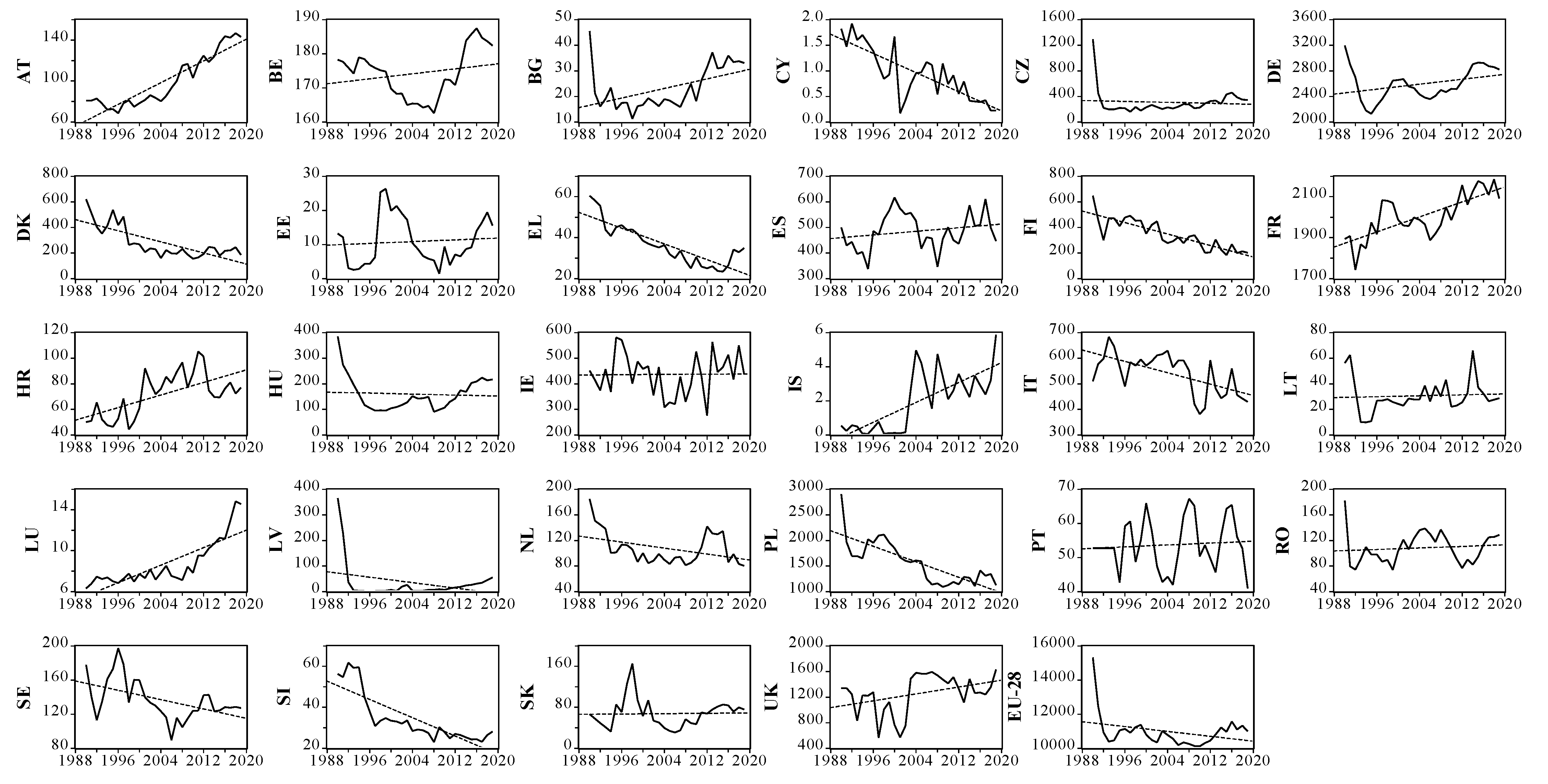
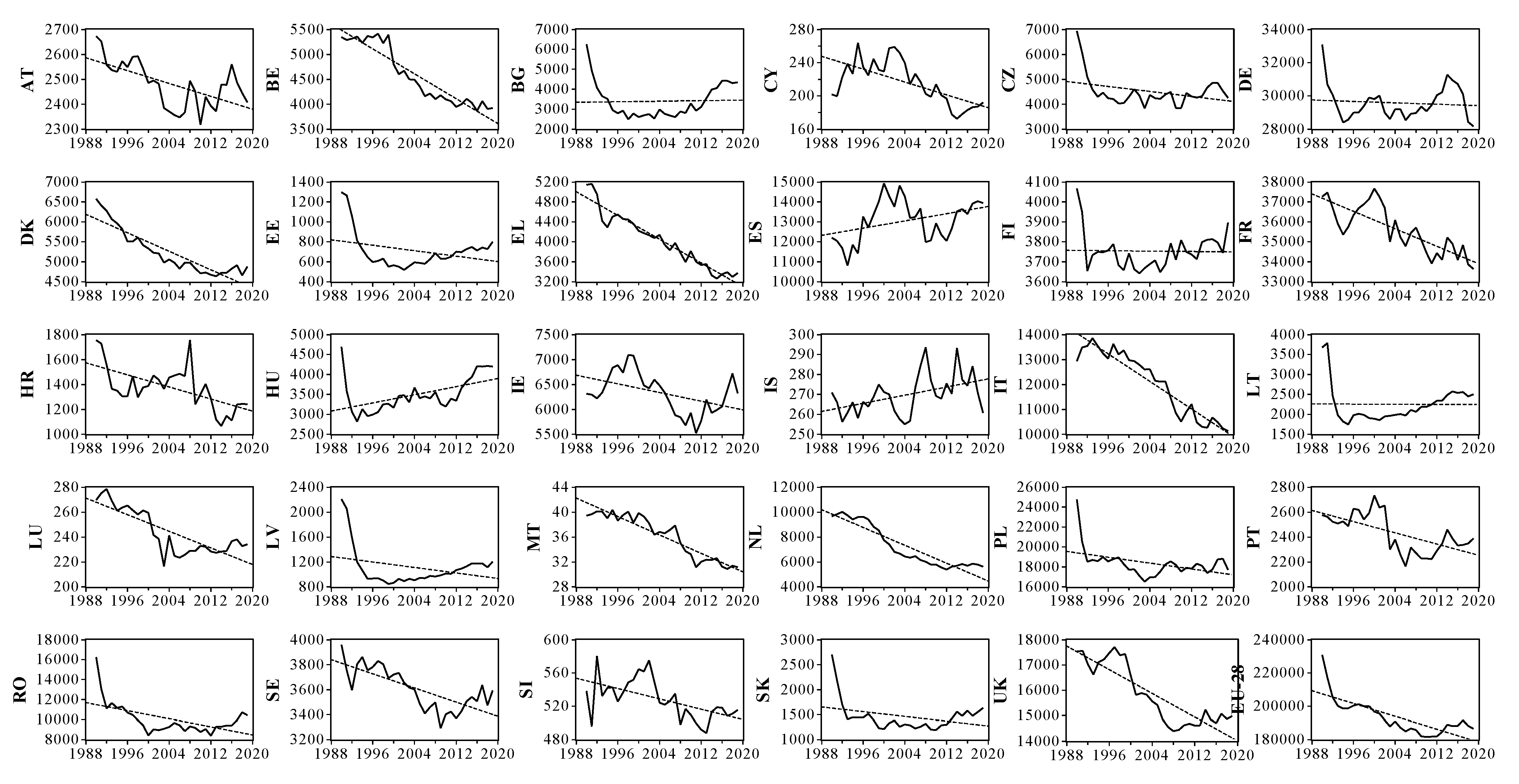
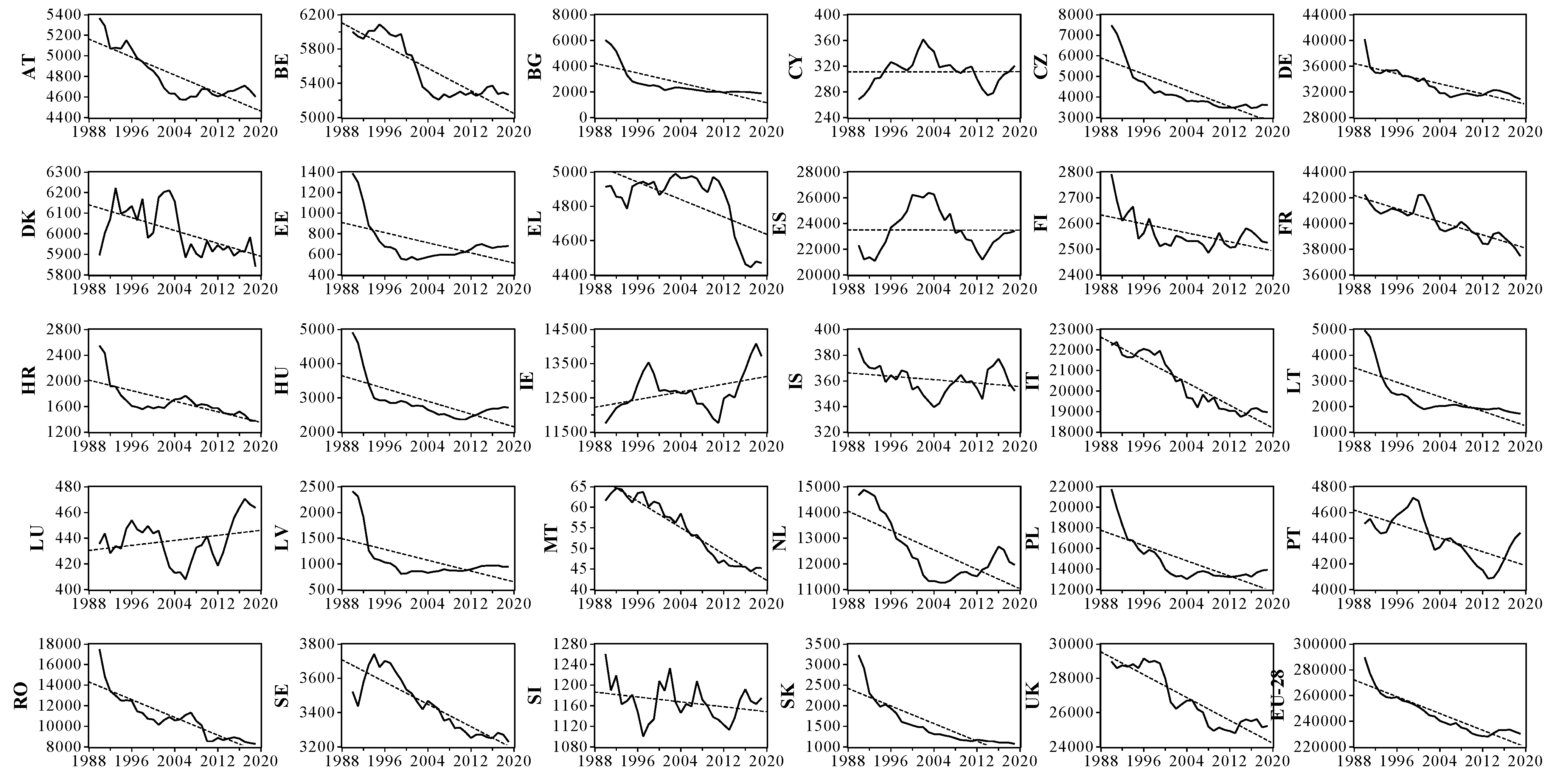
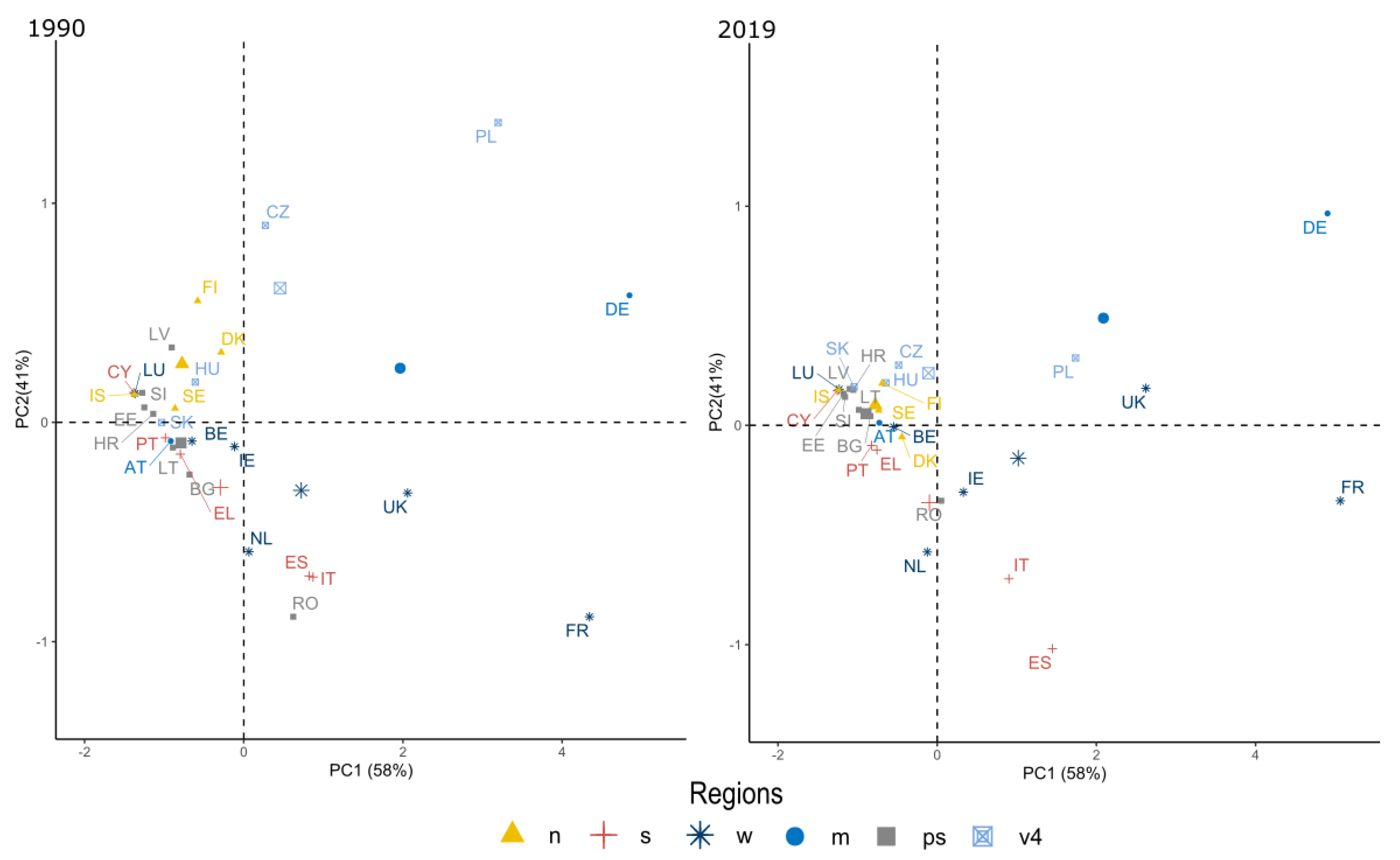
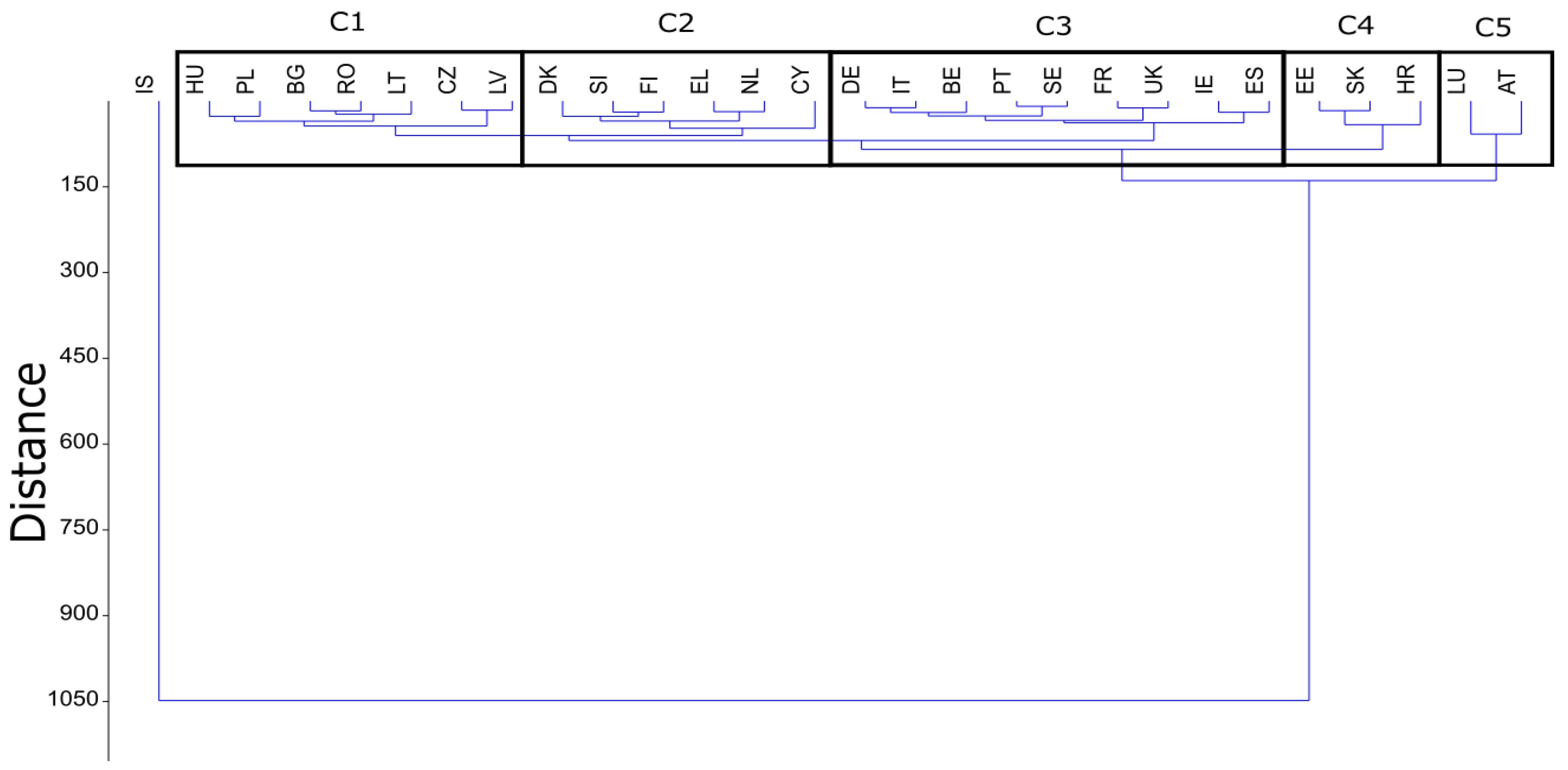
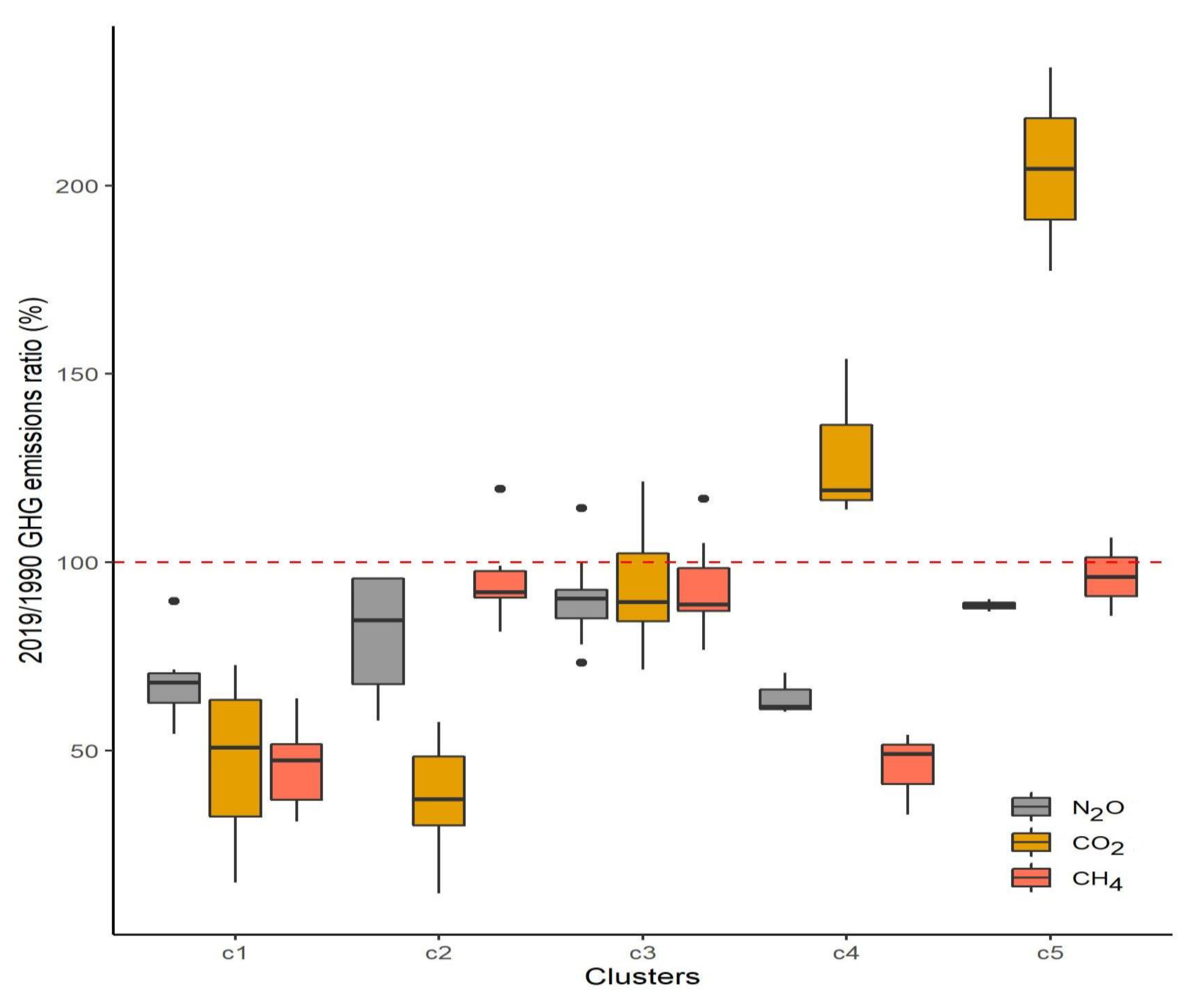
| Data Type | Unit | Time Frequency |
|---|---|---|
| Total GHGs emission from agricultural sector * | Thousand tons | Annual |
| CO2 | Thousand tons | Annual |
| CH4 (CO2 equivalent) | Thousand tons | Annual |
| N2O (CO2 equivalent) | Thousand tons | Annual |
| EU-28 Countries | Total GHGs Emissions | CO2 | CH4 | N2O | |||||
|---|---|---|---|---|---|---|---|---|---|
| MK | MK | MK | MK | ||||||
| Total * | EU-28 | <0.0001 | −2653.01 | 0.42 | −9.61 | <0.0001 | −1675.72 | <0.0001 | −916.06 |
| Belgium | BE | <0.0001 | −92.22 | 0.97 | 0.01 | <0.0001 | −31.48 | <0.0001 | −61.12 |
| Bulgaria | BG | 0.38 | −22.62 | 0.00 | 0.57 | <0.0001 | −42.93 | 0.24 | 23.42 |
| Czechia | CZ | <0.0001 | −65.77 | 0.00 | 5.41 | <0.0001 | −65.89 | 0.70 | −3.03 |
| Denmark | DK | <0.0001 | −78.51 | <0.0001 | −8.98 | 0.00 | −7.76 | <0.0001 | −55.91 |
| Germany | DE | 0.00 | −166.74 | 0.02 | 16.33 | <0.0001 | −177.53 | 0.83 | 5.06 |
| Estonia | EE | 0.72 | 3.00 | 0.40 | 0.14 | 0.83 | −1.22 | 0.30 | 3.55 |
| Ireland | IE | 0.86 | 3.90 | 0.94 | 0.15 | 0.06 | 27.96 | 0.02 | −22.92 |
| Greece | EL | <0.0001 | −73.27 | <0.0001 | −1.03 | 0.09 | −6.02 | <0.0001 | −58.88 |
| Spain | ES | 0.34 | 66.99 | 0.32 | 1.69 | 0.92 | 9.10 | 0.05 | 52.44 |
| France | FR | <0.0001 | −227.20 | <0.0001 | 9.17 | <0.0001 | −122.76 | <0.0001 | −109.34 |
| Croatia | HR | 0.00 | −24.17 | 0.00 | 1.16 | <0.0001 | −16.16 | 0.00 | −11.35 |
| Italy | IT | <0.0001 | −282.61 | 0.00 | −5.26 | <0.0001 | −136.56 | <0.0001 | −143.50 |
| Cyprus | CY | 0.02 | −2.37 | <0.0001 | −0.05 | 0.75 | −0.11 | 0.00 | −2.16 |
| Latvia | LV | 0.57 | 5.62 | 0.01 | 0.74 | 0.36 | −4.73 | 0.04 | 7.97 |
| Lithuania | LT | 0.34 | −7.94 | 0.34 | 0.19 | <0.0001 | −34.91 | 0.00 | 24.14 |
| Luxembourg | LU | 0.17 | −0.91 | <0.0001 | 0.17 | 0.34 | 0.51 | <0.0001 | −1.61 |
| Hungary | HU | 1.00 | 0.07 | 0.18 | 2.44 | <0.0001 | −33.08 | <0.0001 | 37.97 |
| Malta | MT | <0.0001 | −1.18 | - | - | <0.0001 | −0.82 | <0.0001 | −0.37 |
| Netherlands | NL | <0.0001 | −262.91 | 0.01 | −0.99 | 0.00 | −92.96 | <0.0001 | −173.15 |
| Austria | AT | 0.00 | −27.57 | <0.0001 | 2.70 | <0.0001 | −21.41 | 0.00 | −7.01 |
| Poland | PL | 0.00 | −216.02 | <0.0001 | −33.94 | <0.0001 | −137.11 | 0.03 | −36.94 |
| Portugal | PT | 0.00 | −24.21 | 0.83 | 0.03 | 0.00 | −14.47 | 0.01 | −10.32 |
| Romania | RO | <0.0001 | −257.30 | 0.13 | 0.77 | <0.0001 | −187.77 | 0.02 | −72.44 |
| Slovenia | SI | 0.00 | −3.55 | <0.0001 | −0.81 | 0.18 | −1.04 | 0.00 | −1.56 |
| Slovakia | SK | <0.0001 | −43.52 | 0.42 | 0.54 | <0.0001 | −40.52 | 0.48 | −3.10 |
| Finland | FI | 0.00 | −11.64 | <0.0001 | −11.44 | 0.01 | −3.27 | 0.14 | 2.70 |
| Sweden | SE | <0.0001 | −32.85 | 0.02 | −1.05 | <0.0001 | −18.21 | <0.0001 | −15.46 |
| Iceland | IS | 0.46 | 0.27 | 0.00 | 0.13 | 0.13 | −0.45 | 0.02 | 0.49 |
| United Kingdom | UK | <0.0001 | −266.40 | 0.17 | 8.47 | <0.0001 | −161.26 | <0.0001 | −115.55 |
Publisher’s Note: MDPI stays neutral with regard to jurisdictional claims in published maps and institutional affiliations. |
© 2021 by the authors. Licensee MDPI, Basel, Switzerland. This article is an open access article distributed under the terms and conditions of the Creative Commons Attribution (CC BY) license (https://creativecommons.org/licenses/by/4.0/).
Share and Cite
Harsányi, E.; Bashir, B.; Almhamad, G.; Hijazi, O.; Maze, M.; Elbeltagi, A.; Alsalman, A.; Enaruvbe, G.O.; Mohammed, S.; Szabó, S. GHGs Emission from the Agricultural Sector within EU-28: A Multivariate Analysis Approach. Energies 2021, 14, 6495. https://doi.org/10.3390/en14206495
Harsányi E, Bashir B, Almhamad G, Hijazi O, Maze M, Elbeltagi A, Alsalman A, Enaruvbe GO, Mohammed S, Szabó S. GHGs Emission from the Agricultural Sector within EU-28: A Multivariate Analysis Approach. Energies. 2021; 14(20):6495. https://doi.org/10.3390/en14206495
Chicago/Turabian StyleHarsányi, Endre, Bashar Bashir, Gafar Almhamad, Omar Hijazi, Mona Maze, Ahmed Elbeltagi, Abdullah Alsalman, Glory O. Enaruvbe, Safwan Mohammed, and Szilárd Szabó. 2021. "GHGs Emission from the Agricultural Sector within EU-28: A Multivariate Analysis Approach" Energies 14, no. 20: 6495. https://doi.org/10.3390/en14206495
APA StyleHarsányi, E., Bashir, B., Almhamad, G., Hijazi, O., Maze, M., Elbeltagi, A., Alsalman, A., Enaruvbe, G. O., Mohammed, S., & Szabó, S. (2021). GHGs Emission from the Agricultural Sector within EU-28: A Multivariate Analysis Approach. Energies, 14(20), 6495. https://doi.org/10.3390/en14206495









